
by Dr Rick | Mar 11, 2019 | Codependence
Check out:
Brief History of Codependence
How Do Normal Families Adjust To Addiction?
Rescuing Behaviors – First Responders
Suffering Behaviors – Are You A Martyr?
Persecuting Behaviors
Start When The Rescuer Gets Fed Up, Angry and Resentful
Persecuting behaviors comprise the group of behaviors typically experienced by those adjusting to a person with a problem. As noted, the surrounding family members first try to love the identified person into “good” behavior by rescuing or enabling them. It doesn’t work. The rescuer gets fed up, angry and resentful with the person with the problem, and then turns to persecuting behaviors.
The persecutor says things like “Why don’t you grow up! Why don’t you take some responsibility! Why do I have to do everything around here! Why don’t you appreciate what I am doing for you! This is unfair!“

Loved ones become angry because of the identified person’s harmful or embarrassing actions. By definition the identified person has a problem whether it be alcohol, viewing porn, anger, laziness,… etc. Therefore, there is always a “bad’ behavior to be irritated about. A typical reaction to a loved-one’s bad behavior is resentment nagging, threatening, yelling, and blaming.
The position of the persecutor is “It’s all identified person’s fault!” If that person would only stop using alcohol, viewing pornography, get a job, budget their money, or do or not do something – then everything would be okay! Furthermore the persecutor believes he/she can make that change happen if they can yell enough, talk enough, or threaten enough. Or in some cases it’s the “silent treatment” or “cold shoulder.” Either way the message is clear – “I hate this. I resent you. You better stop.”
The diagram below illustrates the common reaction to a person with a problem. One direction is the codependent isolating and experiencing “Suffering Behaviors.” We’ll talk about Suffering Behaviors later. The other common reaction is “Persecuting Behaviors.” Of course recognizing personal feelings and being assertive about those feelings is the healthy behavior.
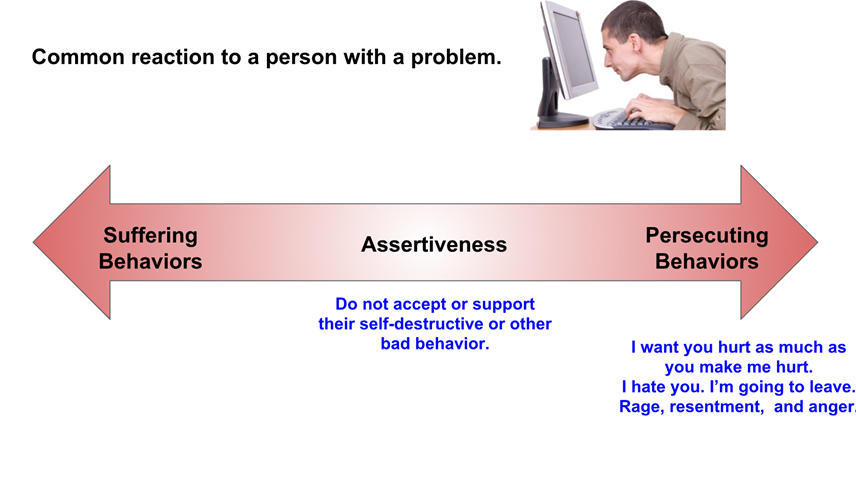
PERSECUTING BEHAVIORS INCLUDE:
Religious activities decrease
Increased religious behaviors which the codpendent tried earlier as a rescuing behavior fail. Reality sets in because the identified person continues to exhibit the unwanted behavior e.g. viewing porn, alcohol regardless of how many prayers were said. The codependent feels that the prayer and other religious activities attempted as rescuing behaviors were unsuccessful. The codependent, out of despair, often turns away from God to his or her own personal power, returning to the previous level of religious activity because “God didn’t solve” the problem.
Threats
 The codependent becomes desperate because all of the attempts to control or fix the addict seem to have failed. He or she may issue a variety of threats during this stage of codependence. These threats are usually extreme in nature. In the case of a spouse, divorce or separation are suggested. Often in the religious family, threats take the form of laying guilt or shame or the addict in and attempt to force the addict into a sobriety. Such threats are unsuccessful because of their extreme nature and the fact that they are seldom implemented. Most common threats include: “Next time I’m divorcing / leaving!” I heard a teen alcoholic explain this best description of a threat, “All my parents do is bark, they never bite.”
The codependent becomes desperate because all of the attempts to control or fix the addict seem to have failed. He or she may issue a variety of threats during this stage of codependence. These threats are usually extreme in nature. In the case of a spouse, divorce or separation are suggested. Often in the religious family, threats take the form of laying guilt or shame or the addict in and attempt to force the addict into a sobriety. Such threats are unsuccessful because of their extreme nature and the fact that they are seldom implemented. Most common threats include: “Next time I’m divorcing / leaving!” I heard a teen alcoholic explain this best description of a threat, “All my parents do is bark, they never bite.”
Nagging behaviors
The persecutor says the same thing over and over again thinking they surely could say the right thing that would eventually change the identified person’s behavior. They subtly insert rude manipulative comments. Perhaps believing they could hurt or shame the identified person enough that of course they would stop the unwanted behavior and start the wanted behavior. At times, the nagging behaviors can be non-verbal like facial expressions, sighs, or simply not talking-cold shoulder treatment.
Irrational Behaviors
As the addiction/ or problem progresses, codependents become increasingly desperate and reach a pint where they will try almost anything to control the addiction problem. One active member of a church placed honey in her husband’s bedding when he continually came home with pornographic magazines. Other common irrational behavior is hiding the laptop, dumping out the alcohol, etc.
Identified person’s response
Well what does the identified person do with the unwanted behavior, They typically continue the unwanted behavior – porn, alcohol etc after being the recipient of the persecuting behaviors feels he deserves it, look, after all, he says to himself, at what I’ve been putting up with.
Here is the Facebook Live video on Persecuting Behaviors.
Follow me on
(C) Docyoucan 2019
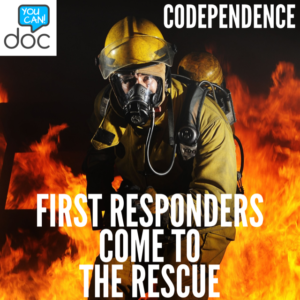
by Dr Rick | Mar 4, 2019 | Codependence
Check out:
Brief History of Codependence
How Do Normal Families Adjust To Addiction?
Persecuting Behaviors
Suffering Behaviors – Are You A Martyr?
FIRST RESPONDERS COME TO THE RESCUE
– IN THE NAME OF LOVE
Generally, it is impossible for those with addictions or other problem behavior to maintain their dysfunctional behavior in isolation. They need a supporting system of codependence.
An addict or person with a problem needs you!
The dysfunctional behaviors developed by surrounding loved ones in an effort to help a person with a problem behavior are referred to as “Codependence.” I refer to these codependent behaviors as Rescuing Behaviors, Persecuting Behaviors, and Suffering Behaviors. It has been my experience.the primary goal of codependence is to help the identified person and to show love. Certainly, there is no great sin in trying to help or to love another person!
Unfortunately codependent behaviors are generally ineffective in changing another person’s behavior. Rescuing Behaviors, Persecuting Behaviors, and Suffering Behaviors tend to support and to maintain the problem behavior. I use the term “identified person” to represent the loved-one with a problem behavior. The problem behavior may be an addiction, mental illness, physical handicap, anger, self-harm, etc.

© Tom Grill/Corbis
In our Christian society, many believe that if a person is in need, we are responsible to help. Behind every irresponsible addict – or identified person – is often a hyper-responsible person. Rescuing behaviors are often the initial response of “first responders”. First responders are among the first to arrive and provide assistance at the scene of an emergency, such as an accident and natural disaster. Their job: identify the problem and provide immediate help. If there is a fire, put it out!
These rescuing behaviors often protect the identified person from immediate consequences of their own irresponsible behavior and prevent growth from occuring.
The damage caused by Rescuing Behaviors include:
- When done in excess the Rescuer becomes worn out, exhausted, etc. Saying, “We can do this.” Really meaning “I’ll do this for you.”
- The identified person with a problem behavior becomes weaker – because someone is doing for them what they could have done for themselves. Saying, “Here let me do this for you.”
- The Rescuer reinforces the identified person’s inability to scuceed. Saying, “You really need my help. You can’t do this.”
Here are examples of a few Rescuing Behaviors.
Denying
Denial is a common behavior developed by surrounding loved ones of an identified person. Several assumptions follow the admission that a member of the family has a problem. One assumption is the false belief, “If there is a problem with them then there must be a problem with me.” In essence, a codpendent assumes they have failed because their loved-one has a problem. If it is your child, then you have failed as a parent. If it is your spouse, then you have failed as a partner. If it is your parent, then you have failed as a child. Much pain, guilt, and confusion come with accepting the truth that a loved one has a problem behavior like addiction.
 The intensity of denial seems greater with those who are sincerely involved in their religion. Often, the more active a person is in religion, the more difficult it will be for them to determine healthy boundaries for helping. A Christian codependent mistakenly equates “Rescuing Behaviors” with “Christ-like love.” Religious persons tend to be so fearful that an addiction or some other problem may be occurring in their family that they deny and overlook the clear signs of it. An analogy that helps explain the concept of denial is that of a child who recently went swimming. If that child were standing dripping wet by the swimming pool, wearing a swimming suit, we would not likely ask questions like “Where have you been? What have you been doing?” Codependents, often confront an identified person in a similar fashion – although clearly observing evidence of a problem behavior whether it be anger, viewing porn, alcohol, etc, a codependent may ask something like “What’s going on?” The most classic case of denial is the codependent acting like nothing is wrong- not talking about “the elephant in the front room.”
The intensity of denial seems greater with those who are sincerely involved in their religion. Often, the more active a person is in religion, the more difficult it will be for them to determine healthy boundaries for helping. A Christian codependent mistakenly equates “Rescuing Behaviors” with “Christ-like love.” Religious persons tend to be so fearful that an addiction or some other problem may be occurring in their family that they deny and overlook the clear signs of it. An analogy that helps explain the concept of denial is that of a child who recently went swimming. If that child were standing dripping wet by the swimming pool, wearing a swimming suit, we would not likely ask questions like “Where have you been? What have you been doing?” Codependents, often confront an identified person in a similar fashion – although clearly observing evidence of a problem behavior whether it be anger, viewing porn, alcohol, etc, a codependent may ask something like “What’s going on?” The most classic case of denial is the codependent acting like nothing is wrong- not talking about “the elephant in the front room.”
Substance abuse example
Perhaps the Golden Question most commonly asked by religious codependents when alcohol, drugs or paraphernalia are found is, ‘Whose is this?” The substance abuser’s Golden Answer is, “I’m holding it for a friend.” We want to believe their responses so we continue to rescue them from the consequences of their behavior by denying the obvious and accepting their lies. Often it takes the equivalent of a Grand Jury conviction for a religious family to admit that a loved one has a problem.
Increased Religious Activities
Religious activities often increase during the first stage of codependency. The codependent firmly believes that fasting, prayer, and careful obedience to each of God’s commandments will cure the addict – identified person. After discovering a family member is using drugs, or pornography, etc loved ones often commit to reading the scriptures, going to church, and having saying more prayers than ever before. The underlying goals for such behavior appears to be “Get God to Fix Him.” The increased religioius activities isn’t the problem. The problem is their purpose is a temporary fix and not a change of heart.
Covering Up
Covering up is a specific behavior that codependents exhibit to clean up or make things better after the identified person has been irresponsible. For example, a wife might call her spouse’s work to report him “ill” with the flu when , in reality he was in bed with a hangover. In an effort to save their child from a police record and experiences in lock-up parents of an identified person will run to the police station to rescue their child. A codependent will clean up the broken glass or hide the empty beer cans to make sure no one finds out. At times a codependent will even miss important church meetings in order to perform the necessary cover-up behaviors.
A codependent often becomes so effective in covering up the consequences of the identified person that even the identified person might very truthfully say “There’s no problem.” In other words, even the identified person does not realize the seriousness of the problems that he or she might be causing because the codependent has done such thorough job in covering up.
Lying
Rescuing behaviors become so intense that codepndents will begin to tell “white lies.” For example, when church leaders, friends and family members ask “How are things going?“, the rescuer responds with “It’s not bad,” or “I’m fine,” or “It’s okay,” The lying process is called “minimization,” and it is a rescuing behavior. The lies are typically unintentional and often unnoticed. A codependent lies to children, to neighbors, to church leaders, and most commonly to self.
Summary:
In summary, typically the identified person – the person with the problem e.g. alcohol use, viewing pornography, anger etc. already believe they can’t change. When you exhibit rescuing / enabling behaviors you’re demonstrating the same- You don’t believe they can change either. 😢
Here is my Facebook Live video on this topic:
The Doc #docyoucan #codependence
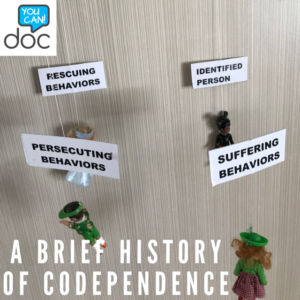
by Dr Rick | Feb 25, 2019 | Codependence
Check out:
How Do Normal Families Adjust To Addiction?
Rescuing Behaviors – First Responders
Persecuting Behaviors
Suffering Behaviors – Are You A Martyr?
A normal healthy family (and even families that aren’t healthy) can adjust to a family member’s “problem behavior” by developing “codependence.” A family member’s “problem behavior” may include such behaviors as: pornography addiction, substance abuse, mental illness, health problems, disabilities, etc. etc. “Codependence” is the name of the dysfunctional behaviors that surrounding family members develop as they adapt to the family member who has the “problem behavior.”
The dysfunctional adaptive behaviors that surrounding family members develop are similar across different circumstances. For example, codependent behavior exhibited by a wife adjusting to a husband’s porn problem would be similar to a dad adjusting to a daughter’s mental illness. In my experience the core components of codependence are:
1) A family member with a problem behavior- some form of addiction, inability, or disability. This behavior can be intentional e.g. alcohol use or a consequence of nature e.g. down’s syndrome. The key ingredient is a family member with a problem and perceived as needing help.
2) A family member (or members) adapting to the person with the problem using a series of dysfunctional coping skills. These dysfunctional codependent behaviors are easily identified and have a pattern.
Of course not all families adjust to another’s problem with codependence, many families adjust in healthy ways.
There are numerous explanations of these patterns of codependence. Here are just a few.
Codependence and 12-Step Groups
Codependence has its’ origin with Al-Anon 12-step family support groups. Al-Anon members are people, who are worried about someone with a drinking problem. Many who go to Al-Anon/Alateen are in despair, feeling hopeless, unable to believe that things can ever change. Al-Anon members want their lives to be different, because they have developed dysfunctioinal coping behavors as they have lived with an “alcoholic.” These codpendent coping behavors have failed to bring about change. Al-Anon teaches its members new coping behaviors whether the alcoholic is still drinking or not. Al-Anon was one of the first organization to promote the concept of “Family Illness.”
Alcoholism is a family disease. The disease affects all those who have a relationship with a problem drinker. Those of us closest to the alcoholic suffer the most, and those who care the most can easily get caught up in the behavior of another person. We react to the alcoholic’s behavior. We focus on them, what they do, where they are, how much they drink. We try to control their drinking for them. We take on the blame, guilt, and shame that really belong to the drinker. We can become as addicted to the alcoholic, as the alcoholic is to alcohol. We, too, can become ill. (Al-Anon).
In fact now we have CODA, CoDependants Anonymous. CODA is a 12-step support group focusing specifically on “Codependence.” CODA has its’ list of Patterns and Characteristics of Codependence. CODA identifies codependent behaviors like: Avoidance Patterns, Control Patterns, Compliance Patterns, Low Self-Esteem Patterns, and Denial Patterns.
Melody Beattie
Melody Beattie, in her book Codependent No More: How to Stop Controlling Others and Start Caring for Yourself, defines a codependent as:
“…One who has let another person’s behavior affect him or her, and who is obsessed with controlling that person’s behavior. The other person might be a child, an adult, a lover, a spouse, a brother, a sister, a grandparent, a parent, a client, or a best friend. He or she could be an alcoholic, a drug addict, a mentally or physically ill person, a normal person who occasionally has sad feelings, or one of the people mentioned earlier.”
The specific signs of codependency can often look different depending on the person experiencing it.
Karpman Drama Triangle
The Karpman Drama Triangle is a social model of human interaction – the triangle maps a type of destructive interaction – codependence, that can occur between people in conflict. The drama triangle model is a tool used in psychotherapy, specifically transactional analysis, and often in 12-step support groups. Here is a brief description of the three “codependent” roles involved in the triangle:
The Victim: (Victim) The Victim’s stance is “Poor me!” The Victim feels victimized, oppressed, helpless, hopeless, powerless, ashamed, and seems unable to make decisions, solve problems, take pleasure in life, or achieve insight.
The Rescuer: (Hero) The rescuer’s line is “Let me help you.” A classic enabler, the Rescuer feels guilty if they don’t go to the rescue. Yet their rescuing has negative effects: It keeps the Victim dependent and gives the Victim permission to fail. The rewards derived from this rescue role are that the focus is taken off of the rescuer. When they focus their energy on someone else, it enables them to ignore their own anxiety and issues.
The Persecutor: (Villain) The Persecutor insists, “It’s all your fault.” The Persecutor is controlling, blaming, critical, oppressive, angry, authoritative, rigid, and superior.
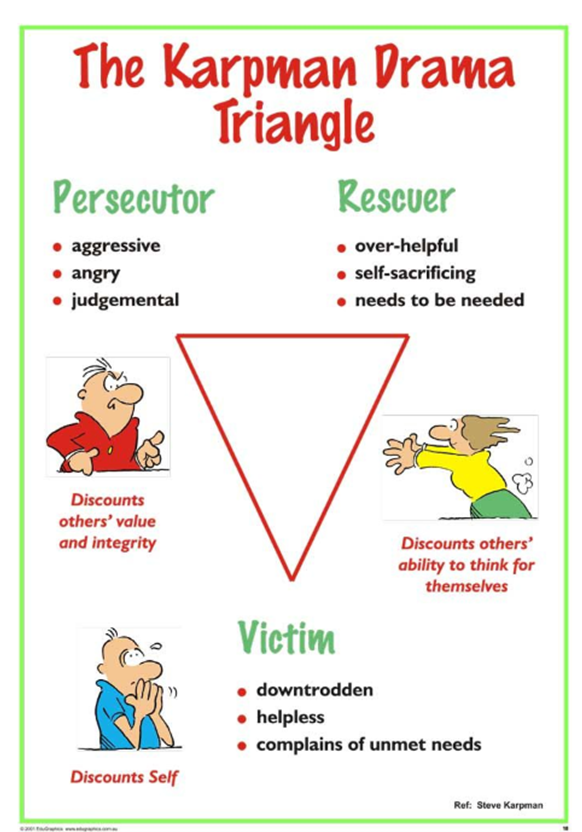
Although tthe names have changed, but the concepts remain the same. Here is a brief video An Introduction to the Drama Triangle. This 3 minute video uses the labels Villain, Hero, and Victim to explain the copdependent roles involved in the Drama Triangle.
Over the years, everyone seems to have come on board with their own perspective of codependence. Here’s Oprah’s take. For example check-out her article How to Stop Being a Martyr.
Here is my Facebook Live video on this topic:
Next go to Rescuing Behaviors- First Responders

by Dr Rick | Feb 18, 2019 | Codependence, Self-Love
Having worked in the psychological profession for 40+ years I’ve learned techniques to determine whether or not a individual is emotionally healthy. One of the best and most effective way is determining the level of focus one has on him/herself. Here is the “Self-Love Meter” diagram I use when I talk about self- foucs.
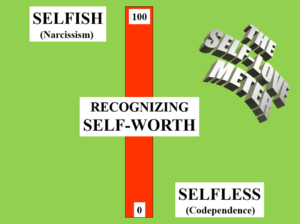
SELFLESS (CODEPENDENCE)
This is how the “Self-Love Meter” works. The meter begins at the bottom and is identified with a “0” with the words “Selfless – (Codependence)”. Codependence is an extreme of self-love. It is a dysfunctional form of loving others. It occurs when one becomes so preoccupied about working out another’s problems that one’s own problems becomes neglected. A personal experience can teach this idea. As a psychologist, I often have the opportunity to be in psychiatric wards. I recall one occasion when a good member of a local Christian church was hospitalized. The referring psychiatrist described her as having so overextended herself in serving others that she had experienced what many would call a “nervous breakdown.” I arrived at the hospital early Saturday morning and began to look for this patient. She wasn’t in her room or on the wing. As I poked my head into her assigned room, all I saw was a small pile of what appeared to be dirty laundry on her bed. I asked at the nurse’s desk and discovered that this good sister was across the hall doing the laundry of fellow patients. This Christian Sister always went the “extra mile” no matter what her personal circumstances. If the Clergy needed her to visit someone or do something, she was always there. She had a very hard time in saying “no.” She would leave her home immediately when called upon, whether eating dinner with her family, reading her scriptures, or even while praying. Even while in the hospital she was found doing the laundry of other patients while her own laundry was left undone. This sister truly lost herself in the service of others. She believed that by “giving, giving, giving” she would find peace and happiness. Instead, she found herself inpatient in a psych ward.
“Selfless” is characterized by: No pleasure in receiving; Interest only in others; Wants everything for others; Sees nothing but others; Overlooks needs of self; and Helps others avoid pain. She has withdrawn love from self and turned it towards others. In conclusion, using a faith-based scenario she was so busy serving others she was distant from “God.”
SELFISH (NARCISSISM)
The meter ends at the top and is identified with a “100” with the words “Selfish – (Narcissism)”. Selfish example: The myth of Narcissus is one of the most known Greek Myths, due to its uniqueness and moral tale; Narcissus, was the son of River God Cephisus and nymph Lyriope. He was known for his beauty and he was loved by God Apollo due to his extraordinary physique. Narcissus was the object of the passions of many young women and nymphs, but he was indifferent to it all. The nymph Echo, fell in love with him but she could get no more from him than the others could. In despair, she withdrew into a lonely spot where she faded away until all that was left of her was her sorrowful voice. Because Narcissus didn’t love her the ways she wanted him too.The young women rejected by Narcissus asked the heavens for vengeance. Nemesis heard them and arranged for Narcissus’ punishment. One very hot day, Narcissus bent over a stream to take a drink and saw his own face, which was so handsome he immediately fell in love with it. From then on the stayed there watching his own reflection until he died. This narcissism occurs when a person becomes so preoccupied with him/herself that he/she neglects others. A narcissist only thinks of themselves. He has withdrawn love from others and turned it toward self. Narcissus believed that by “taking, taking, taking” he would find peace and happiness. Over the years I’ve been involved sending many folks with “narcissistic” traits to prison!
“Selfish” is characterized by: No pleasure in giving; Interest only in self; Wants everything for self; Sees nothing but self; Overlooks needs of others; and Avoids personal pain. In conclusion, using a faith-based scenario Narcissus was so busy serving himself he was distant from “God.”
SELF-WORTH
Self-worth, a healthy emotional state, is a balance between the two “focus on self” and “focus on others.” However, there is one overriding principle:
When you become so preoccupied and worried about another person that they neglect their own personal – emotional, physical and spiritual needs – It is always dysfunctional.
A person with a healthy self-worth receives and gives with pleasure; Interested in self & others.There are certain emotional, physical, and spiritual needs each of us have. We are responsible for meeting these needs. You will have to decide what those emotional, physical and spiritual needs are for yourself. For me, there is a certain amount of sleep I need; time to ponder and read scriptures; and certain amount of exercise.
Join me in Facebook Life: When Love Becomes Codependence
by Dr Rick | Feb 4, 2019 | #pornprevention
ONE QUESTION YOU SHOULD ASK YOUR KID
You want to prevent underage viewing of pornography in your family? Here’s how …
Have ongoing conversations with your kid about: sexual messaging, pornography, body parts, dating, sexual behavior, and personal religious beliefs and values.
The best pornography prevention tool available is a “parent.”
A parent having conversations with their kid.
Here are some quick research facts: About 10% of the parents nationally have had conversations about pornography with their children. That means 90% of us have never had a conversation about porn with our kids!!
Having ongoing conversations with our kids directly reduces “Risky Sexual Behaviors.” (“Risky Sexual Behaviors” is a term used by researchers to include all kinds of unwanted sexual behavior such as viewing porn, sexual intercourse etc. ) Risk for “Risky Sexual Behaviors” increases – When a kid learns exclusively about sex from pornography. With frequent parent-child conversations even if your kid is viewing porn it won’t be his/her exclusive source about sexual knowledge. Risk for “Risky Sexual Behaviors” increases – When a kid first learns about sex from pornography. With early parent-child conversations sexual knowledge will come first from parents and not porn.
Do you understand the importance of this concept? The most powerful resource available to prevent underage viewing of pornography (or any Risky Sexual Behavior) is a parent having conversations about sexual topics with their kid.
WAYS TO INITIATE THOSE CONVERSATIONS- “TAKE THEIR TEMPERATURE”
I use the phrase “Take Their Temperature” to represent a technique to see how a child is doing. A parent can initiate a conversation with a child / take their temperature in two ways
- Ask questions
- Anywhere anytime learning
Each of these techniques allow the parents to “Take Their Child’s Temperature”.
SAMPLE QUESTION
Let me give you one question to help you get started.
Magic Questions. Over the past 40 years I’ve interviewed thousands questions to sex offenders-youngest age 9 and the oldest 85. Each with at least one felony sex charge. In attempts to determine problem and need for therapy I’ve tried many different questions trying different words or phrases in an attempt to find the “Magic Question.” A question that would give me the most information without alarming the client. During those years there are probably 5 or so questions that have proven to be a “Magical Questions.”
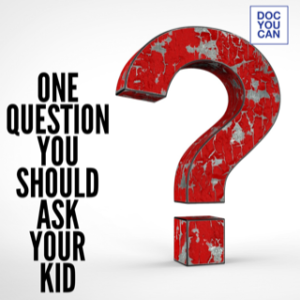 This is one of the best “Temperature Taking Questions” I know of:
This is one of the best “Temperature Taking Questions” I know of:
WHAT PART OF ANOTHER PERSON’S BODY IS WRONG FOR YOU TO TOUCH?
I usually ask the question in two parts: “What parts of a girl’s body would be wrong for you to touch?” and “What parts of a boy’s body would be wrong for you to touch?”
This is one of the few questions I have consistently used to assist me in determining the extent of problems and need for treatment – “Take a person’s temperature”. Here’s why I recommend you asking your child these two questions.
First, you can learn quickly if your child knows acceptable “Good-Touch Bad Touch” rules. On a boy – it’s penis and butt. On a girl – it’s vagina, breasts, and butt. Why? Because in most states and countries unwanted touching of these areas by another person is usually a criminal offense, often a felony. And, we don’t want your child to get sexual charges.
- 🔥 Using the “take the temperature” comparison- This child who really doesn’t know “good touch – bad touch” definitely needs some education.
Second, how your child answers, tells you how comfortable they are in talking about sexual topics. Common responses are “Do I have to say the word?” Or other responses suggesting a reluctance to talk about the topic raises concerns. It’s always amazed me how a teen can have 5 felony sexual charges, on his way being removed from the home, etc., yet can’t say the word “penis or vagina.”
- 🔥 Using the “take the temperature” comparison- This child that has difficulty even saying the names for body parts with you is definitely running a temperature. Something is wrong! Perhaps your relationship with your child isn’t strong enough to have such a conversation or perhaps your child simply feels shame or guilt about the topic.
Third, how your child answers tells you how they view sexuality. Answering the questions with slang at times very vulgar slang words, suggests a view of sexuality that tends to objectify the body for sexual purposes. I had a young man this past week respond with a word for a sexual body part that was vulgar – but he said it with ease.
- 🔥 Using the “take the temperature” comparison- This child that uses slang may objectify the body for sexual purpose may be running a fever and may need some additional help.
Fourth, when your child answers with the words penis, vagina, butt, and breast in a conversational tone, you’re there! With these answers, I suspect an adequate perception of sexuality and ability to talk about it.
- ⛄ Using the “take the temperature” comparison- This child likely does not need additional resources.
NOTE: If they answer with the word “Privates” I quickly add and what names do you use for a male’s/female’s privates?
Taking the temperature of you the parent: 😉
In this process, I am also “taking the temperature” of you, the parent. As you ask your child these questions pay attention to your voice your feelings. How comfortable you are in asking these two questions? How comfortable are you in listening to the answers? If you can’t have this conversation with your child, you’ll never be able to have the more challenging sexual conversations.



 The codependent becomes desperate because all of the attempts to control or fix the addict seem to have failed. He or she may issue a variety of threats during this stage of codependence. These threats are usually extreme in nature. In the case of a spouse, divorce or separation are suggested. Often in the religious family, threats take the form of laying guilt or shame or the addict in and attempt to force the addict into a sobriety. Such threats are unsuccessful because of their extreme nature and the fact that they are seldom implemented. Most common threats include: “Next time I’m divorcing / leaving!” I heard a teen alcoholic explain this best description of a threat, “All my parents do is bark, they never bite.”
The codependent becomes desperate because all of the attempts to control or fix the addict seem to have failed. He or she may issue a variety of threats during this stage of codependence. These threats are usually extreme in nature. In the case of a spouse, divorce or separation are suggested. Often in the religious family, threats take the form of laying guilt or shame or the addict in and attempt to force the addict into a sobriety. Such threats are unsuccessful because of their extreme nature and the fact that they are seldom implemented. Most common threats include: “Next time I’m divorcing / leaving!” I heard a teen alcoholic explain this best description of a threat, “All my parents do is bark, they never bite.” 


 The intensity of denial seems greater with those who are sincerely involved in their religion. Often, the more active a person is in religion, the more difficult it will be for them to determine healthy boundaries for helping. A Christian codependent mistakenly equates “Rescuing Behaviors” with “Christ-like love.” Religious persons tend to be so fearful that an addiction or some other problem may be occurring in their family that they deny and overlook the clear signs of it. An analogy that helps explain the concept of denial is that of a child who recently went swimming. If that child were standing dripping wet by the swimming pool, wearing a swimming suit, we would not likely ask questions like “Where have you been? What have you been doing?” Codependents, often confront an identified person in a similar fashion – although clearly observing evidence of a problem behavior whether it be anger, viewing porn, alcohol, etc, a codependent may ask something like “What’s going on?” The most classic case of denial is the codependent acting like nothing is wrong- not talking about “the elephant in the front room.”
The intensity of denial seems greater with those who are sincerely involved in their religion. Often, the more active a person is in religion, the more difficult it will be for them to determine healthy boundaries for helping. A Christian codependent mistakenly equates “Rescuing Behaviors” with “Christ-like love.” Religious persons tend to be so fearful that an addiction or some other problem may be occurring in their family that they deny and overlook the clear signs of it. An analogy that helps explain the concept of denial is that of a child who recently went swimming. If that child were standing dripping wet by the swimming pool, wearing a swimming suit, we would not likely ask questions like “Where have you been? What have you been doing?” Codependents, often confront an identified person in a similar fashion – although clearly observing evidence of a problem behavior whether it be anger, viewing porn, alcohol, etc, a codependent may ask something like “What’s going on?” The most classic case of denial is the codependent acting like nothing is wrong- not talking about “the elephant in the front room.” 



 This is one of the best “Temperature Taking Questions” I know of:
This is one of the best “Temperature Taking Questions” I know of: